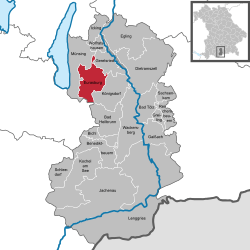Eurasburg
| Eurasburg | ||
|---|---|---|
| ||
 Eurasburg | ||
Location of Eurasburg within Bad Tölz-Wolfratshausen district  | ||
| Coordinates: 47°52′0″N 11°24′0″E / 47.86667°N 11.40000°ECoordinates: 47°52′0″N 11°24′0″E / 47.86667°N 11.40000°E | ||
| Country | Germany | |
| State | Bavaria | |
| Admin. region | Oberbayern | |
| District | Bad Tölz-Wolfratshausen | |
| Government | ||
| • Mayor | Michael Bromberger (Gemeinsame Wählervereinigung) | |
| Area | ||
| • Total | 40.9 km2 (15.8 sq mi) | |
| Population (2015-12-31)[1] | ||
| • Total | 4,316 | |
| • Density | 110/km2 (270/sq mi) | |
| Time zone | CET/CEST (UTC+1/+2) | |
| Postal codes | 82547 | |
| Dialling codes | 08179, (08171 in Achmühle) | |
| Vehicle registration | TÖL and WOR | |
| Website | www.eurasburg.de | |
Eurasburg is a municipality in Oberbayern (Upper Bavaria). It is situated about 40 kilometres (25 miles) south of the Bavarian state capital, Munich, in the county of Bad Tölz-Wolfratshausen.
Since the redistricting reforms of 1978, the municipality of Eurasburg has had an area of 40.9 square kilometres (15.8 sq mi), which includes 52 communities. The two largest communities are Eurasburg and Beuerberg. The municipality has a population of about 4,400.
History
The Irings established their fiefdom in the Loisach valley. It covered an area from Herrenhausen to Lake Starnberg and from Wolfratshausen to the fief belonging to Benediktbeuern Abbey. The castle built by the Irings, Iringsburg, gave the community its name.
Albert von Iringsburg, as a follower of Emperor Henry IV, was anathematized by Pope Gregory VII. To atone for her father and husband, Berta von Iringsburg and her sons Otto and Eberhard founded an Augustine monastery in 1121, which is now in the hands of the Salesians of Don Bosco. The abbey administered all church possessions in the whole fiefdom.
Albert VI of Bavaria tore down the old Iringsburg in 1626. The manor house which stands today was built in the late Renaissance style according to the design of Peter Candid. The manor house burned down in 1976. It was rebuilt in the 1980s and subsequently subdivided into private apartments.
In the concluding stages of World War II in Europe, a death march of former prisoners from the Dachau concentration camp headed southwards to, and then turned eastwards[2] from Eurasburg, headed towards Waakirchen where the U.S. Army's 522nd Field Artillery Batallion of segregated Nisei troops rescued them on May 2, 1945.[3]
Cultural and historical sites
Eurasburg is also home to Beuerberg Abbey, founded in about 1121 and renovated in the 18th century, and containing architecture from the 12th to the 18th centuries. It was dissolved in the secularisation of 1803. Today, the premises are occupied by the Visitandines.
Twin towns
Eurasburg is twinned with:
References
- Notes
- ↑ "Fortschreibung des Bevölkerungsstandes". Bayerisches Landesamt für Statistik und Datenverarbeitung (in German). June 2016.
- ↑ Todesmärsche Dachau memorial website's map page of KZ-Dachau death march
- ↑ "Central Europe Campaign – 522nd Field Artillery Battalion". Retrieved 2015-01-12.
In fact, the brutal death marches south had already begun on April 24. Jewish prisoners from the outer Dachau camps were marched to Dachau, and then 70 miles south. Many of the Jewish marchers weighed less than 80 pounds. Shivering in their tattered striped uniforms, the "skeletons" marched 10 to 15 hours a day, passing more than a dozen Bavarian towns. If they stopped or fell behind, the SS guards shot them and left their corpses along the road. Thousands died from exposure, exhaustion, and starvation. On May 2, the death march was outside Waakirchen, Germany, near the Austrian border, when the 522nd came across the marchers. That day, soldiers from the 522nd were patrolling near Waakirchen. The Nisei saw an open field with several hundred "lumps in the snow." When the soldiers looked closer they realized the "lumps" were people. Some were shot. Some were dead from exposure. Hundreds were alive. But barely. The 522nd discovered hundreds of prisoners with black and white prison garb, shaven heads, sunken eyes, and hollowed cheeks. Some roamed aimlessly around the countryside. Some were too weak to move. All were severely malnourished. One soldier gave a starving Jewish prisoner a candy bar, but his system couldn't handle solid food. Then the Americans were told not to give food to the prisoners because it could do them more harm than good. For the next three days, the Nisei helped the prisoners to shelter and tended to their needs as best as they could. They carried the survivors into warm houses and barns. The soldiers gave them blankets, water and tiny bits of food to ease them back from starvation. The soldiers left Waakirchen on May 4, still deeply disturbed by the harrowing scenes of the Jewish prisoners.
- ↑ "Rybnik Official Website - Twin Towns".
 (in English) © 2008 Urząd Miasta Rybnika, ul. Bolesława Chrobrego 2, 44-200 Rybnik. Retrieved 2008-11-01.
(in English) © 2008 Urząd Miasta Rybnika, ul. Bolesława Chrobrego 2, 44-200 Rybnik. Retrieved 2008-11-01.
